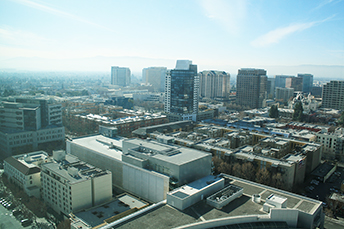The delusions of an American Technopolis
The McEnery administration took large swaths of agricultural land in northern San Jose and, creatively stretching the intended legislative definition, declared them “blighted.” This brought them under the purview of the redevelopment agency, which leveled the farmland and subsidized the construction of expansive industrial parks. In another inventive legal maneuver that pushed the boundaries of redevelopment, McEnery then diverted the revenues generated by this new industrial tax base into his one true ambition: revitalizing San Jose’s downtown. The postwar decades of breakneck suburbanization had drawn the life out of the city’s small but bustling center. McEnery, who grew up downtown and whose family had several commercial holdings there, had watched the neighborhood waste away. He resented Dutch Hamann’s growth machine, so he set about creating his own.
During McEnery’s administration, through the ’90s and beyond, downtown San Jose was completely transformed, donning the appearance of a major urban center’s commercial district: broad avenues lined with office buildings and luxury hotels, a convention center and a sports arena, and museums of art and technology. Some $2 billion went into this wholesale rebuilding of the city core.
McEnery’s grandiose downtown vision sought to wrench the city once and for all out of its “identity crisis” by linking San Jose directly to the economic lifeline of the region’s high-tech industry. Where San Jose had been a generic, if large-scale, suburb, “I intended to annex the virtual city of Silicon Valley, to make San Jose known as the ‘capital’ of that ethereal realm,” McEnery wrote in “The New City-State.” The guiding principle was that such a reinvention would benefit the community as a whole by growing the city’s tax base, attracting and creating jobs, and turning San Jose into an economically vital urban center.
But in several crucial ways, redevelopment in San Jose constituted what Rhee describes as “a massive regressive transfer of resources.” Redevelopment in California was funded by a mechanism called tax increment financing, whereby any increase in property taxes caused by a redevelopment project was funneled back into the redevelopment agency. This means that money generated by industrial growth did not go to school districts, to the state, to the county (which runs most social welfare programs), or even to the rest of the city’s budget.
Instead, the money went to developers and real estate interests, directly or indirectly. In this crucial respect, McEnery’s growth machine was not so different from Hamann’s. “Redevelopment was a giant subsidy machine,” said Bob Brownstein, the research director at Working Partnerships who was the city’s budget manager in the mid-’90s. “It either subsidized the infrastructure or subsidized the development itself.”
Much of this money went into direct subsidies to attract businesses like hotels to the city’s core: press reports estimated $38 million to the Fairmont, $19 million to the Hilton, and so forth. The total of direct subsidies is at least in the tens of millions, and likely in the hundreds of millions, but the precise sum is unclear — the distribution of redevelopment dollars was notoriously opaque. “Reading a redevelopment budget was like reading an encoded document without having the code,” Brownstein said.
The redevelopment fever marked the apex of what Rhee identified as the regime of selective austerity. In times of fiscal trouble, San Jose and the Santa Clara County would trim budgets for community centers, parks, and other social services. Yet, both because of the various legal structures protecting it and the zealousness and power of its champions, the redevelopment agency’s profligacy tended to go undisturbed. Occasional but important exceptions came only after years of sustained pressure from grassroots advocates of causes like affordable housing and community development.
California’s current governor, Jerry Brown, ended redevelopment statewide in 2011. But the pattern of prioritizing economic development at the expense of social spending, according to Rhee, holds to this day, even if the mechanisms have changed. “The politics of selective austerity have deeply, deeply taken hold,” Rhee said. “This is one of the wealthiest areas in the country, but at the same time there’s an acceptance that there just ‘isn’t enough’ for a lot of basic social needs — even though there’s always been enough for development.”
Do right by us, and everybody wins
In 1992, tech firms in Silicon Valley were going through a slump. Job growth was slow, venture capital was declining, and companies were spending less on research and development. In response, business leaders formed Joint Venture Silicon Valley, a coalition of corporate interests, most of them in high-tech. As Newman chronicles in “Net Loss,” Joint Venture went on to play an outsize role in shaping regional politics for years to come.
The founding document of Joint Venture, a report entitled “An Economy at Risk,” sounded a somber tone about the economic future of the Santa Clara Valley. Tech firms were restructuring to respond to globalizing markets and international competition, outsourcing manufacturing work and becoming, as they would describe it, nimbler and leaner. As such, cities in the region stood to lose the immediate economic advantages of having such corporations in their midst.
In light of these changes, Joint Venture presented three possible scenarios for the region. In all three, tech firms adapted to globalization and stayed profitable, but only in one would the benefits be shared throughout the surrounding communities. The report christened this scenario the “American Technopolis” — “a dynamic community that supports technology enterprises and retains value added, employment, and wealth.” In the American Technopolis, “companies and the community both win.”
By Joint Venture’s estimation, the metrics of such broadly shared, regional success were employment growth, a rising per capita income, and investment in the types of public infrastructure that met the needs and expectations of the tech sector. One of Joint Venture’s prescriptions for achieving this was the creation of a “pro-competitive” regulatory and tax environment, meaning few regulations and low taxes. Indeed, one of Joint Venture’s early successes was winning a sales tax waiver for commercial and industrial equipment.

